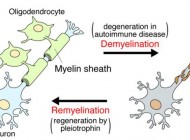New Study Unravels How Myelin is Repaired, May Suggest New MS Treatments

Sept 3, 2015 – Japanese scientists have discovered new information about how the myelin sheath is repaired following damage. Myelin is a fatty substance that wraps around nerve cells and helps them to conduct impulses. The research could have major implications for how multiple sclerosis is understood and even treated. The study, titled “Inactivation of Protein Tyrosine Phosphatase Receptor Type Z by Pleiotrophin Promotes Remyelination through Activation of Differentiation of Oligodendrocyte Precursor Cells,” appeared in the Journal of Neuroscience on September 2, 2015.
The symptoms of multiple sclerosis are due to an immune attack on the body’s own myelin. When myelin is lost around nerve cells, this can cause unpredictable loss of movement, sensation, vision problems and feelings of pain. Myelin is made by special nervous system cells called oligodendrocytes. Although it is well-known that myelin can be repaired by oligodendrocytes if it is damaged scientists do not understand the exact repair mechanisms used by these cells. In MS, myelin unfortunately does not appear to be easily repaired, also for unknown reasons.
The researchers, led by Professor Masaharu Noda and colleagues of the National Institute for Basic Biology, wanted to study how myelin is repaired in mice with an experimental form of MS, induced by the myelin-damaging drug cuprizone. They studied both normal mice and genetically-altered mice that lacked protein tyrosine phosphatase receptor type Z (PTPRZ), which is a protein that may cause oligodendrocytes to turn into mature cells, rather than stay in a more immature stage.
Continue Reading
~~~~~~~~~~~~~~~~~~~~~~~~~~~~~~~~~~~~~
MS Views and News helps to provide information for all affected by MS
Keep up to date with the news and information we provide
.======================================================
Visit our MS Learning Channel on YouTube: http://www.youtube.com/msviewsandnews
Stay informed with MS news and information - Sign-up here
For MS patients, caregivers or clinicians, Care to chat about MS? Join Our online COMMUNITY CHAT




